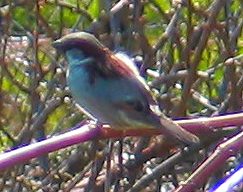 A classic study done over a century ago has provided the data for many studies on limiting factors of the environment, See this PDF, partially quoted here from The Condor Journal : For the complete article go to http://elibrary.unm.edu/sora/Condor/files/
A classic study done over a century ago has provided the data for many studies on limiting factors of the environment, See this PDF, partially quoted here from The Condor Journal : For the complete article go to http://elibrary.unm.edu/sora/Condor/files/
issues/v094n04/p0944-p0954.pdf
INTRODUCTION
Nearly a century ago, Hermon Bumpus received 136 House Sparrows (Passer domesticus) that had been collected after a severe winter storm in Providence, Rhode Island (Bumpus 1899). Over half of these birds revived in his laboratory and Bumpus proceeded to evaluate physical characteristics that might distinguish these survivors from their dead counterparts. He concluded that the storm had taken a greater toll on individuals whose morphometrics deviated most from the “ideal type” (Bumpus 1899). Bumpus was unabashed in claiming this pattern of differential survival to be due to the agency of natural selection. The provocative nature of his interpretation, coupled with publication of the complete data set on which it is based, has prompted repeated analysis of Bumpus’ study (e.g., Harris 1911, Calhoun 1947, Grant 1972, Johnston et al. 1972, Lande and Arnold 1983, Crespi and Bookstein 1989). Studies reappraising the Bumpus data generally agree that females suffered proportionately greater mortality than males and that female survivorship reflects stabilizing or normalizing selection (Grant 1972, Johnston et al. 1972, Lande and Arnold 1983). Disagreement persists, however, in deciding whether male survivorship reflects directional selection and, if so, whether this selection favors larger (Johnston et al. 1972) versus smaller individuals (Lande and Arnold 1983, Clutton-Brock 1988). Such contradictory conclusions from the same data set reflect differences in confidence that var- ious authors place in Bumpus’ morphometric measures. Those accepting at face value all nine of Bumpus’ morphometric measures conclude that the winter storm selected against larger adult males, because male survivors had significantly less mass and shorter total length than did their dead counterparts. On the other hand, some contend that his measures involving plumage (alar extent and total length) and mass may be biased, albeit for different reasons, and should not be considered when comparing characteristics of survivors to non-survivors (Calhoun 1947, Grant 1972, Johnston et al. 1972, Crespi and Bookstein 1989). When analysis is restricted to each of the six skeletal measures, adult male survivors and non-survivors cannot be distinguished from one another.
FOR FURTHER INVESTIGATION:
The following original papers present the arguments for natural selection by abiotic factors in the environment:BUMPUS, H. C. 1899. The elimination of the unfit as illustrated by the introduced House Sparrow, Passer domesticus. Biol. Lectures, Marine Biol. Lab., Woods Hole:209-226.
JOHNSTON, R. F., D. M. NILES, AND S. A. ROHWER. 1972. Hermon Bumpus and natural selection in Passer domesticus.
PRICE, T. D., P. R. GRANT, H. L. GIBBS, AND P. T. BOAG. 1984. Recurrent patterns of natural selection in a population of Darwin’s Finches. Nature 309:787-789.
Return to the Assignment on Ecosystem Structure and Function
Return to the OceanQuest Index
